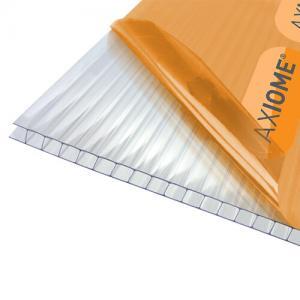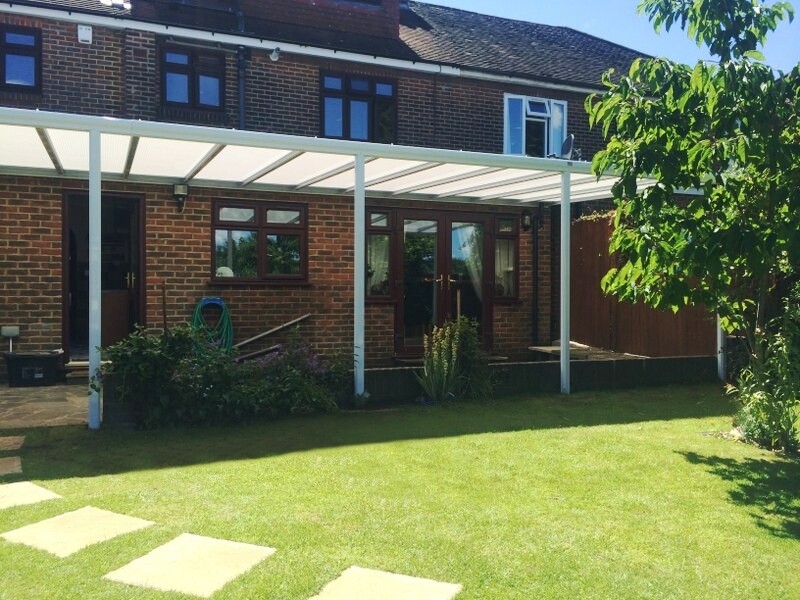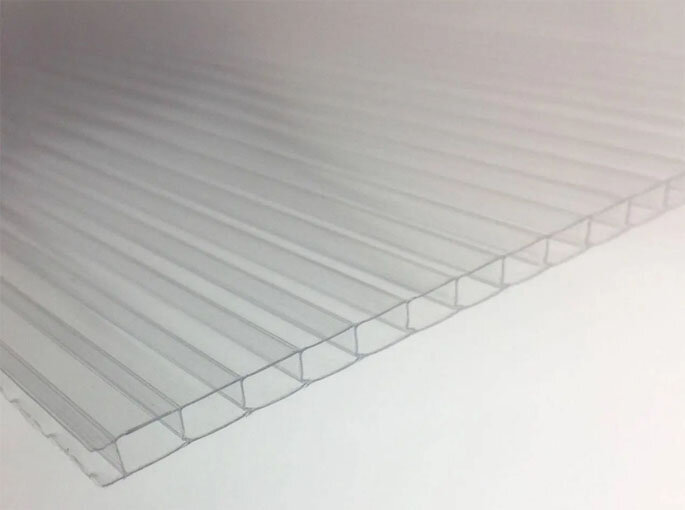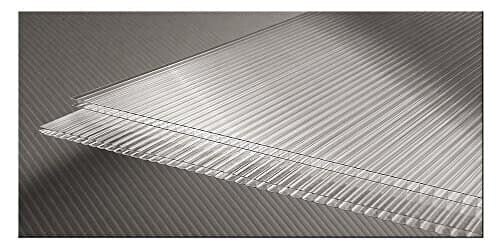Polycarbonate sheets are something that many people query as they are suitable for both domestic and commercial roofing. On the surface, polycarbonate sheets might seem simple enough to understand but there is more to this roofing solution than meets the eye.
It is a common solution that is often used in outdoor structures such as conservatories and other garden fixtures. It has become a popular material because of the way in which it offers durability and a high level of strength. In fact, it is as much as 250 times stronger than glass, which is why it is becoming a better alternative. As far as plastic roofing material goes, both twin wall and multiwall polycarbonate are becoming increasingly popular. This is down to the fact that it is a lightweight material and cost-effective. Furthermore, it is a material that is simple to work with and install.
What is Polycarbonate Roofing and Glazing?

This material is made of strong plastic that is lightweight, strong and has the ability to handle high temperatures. Furthermore, it can also keep temperatures low inside the likes of conservatories and carports. This is the reason why more people are choosing to use this plastic material.
Choosing the Right Thickness of Polycarbonate Sheets for Roofing
Using this product will mean that you have several options to consider. There are Twinwall and Multiwall sheets to consider and while they both share the same properties, they do offer different levels of insulation. So, the more layers that are included, the better the insulation will be. Furthermore, the more layers there are, the more your boards will cost.
One thing you will need to consider is how much insulation you require. The amount of additional heating you require will determine how thick multiwall polycarbonate you will need. There are several options available when it comes to the thickness of polycarbonate and these are suitable for different purposes.
-
4mm Sheets – These acrylic sheets are commonly used in plant houses or cloches
-
6mm Sheets – This plastic sheet is used for swimming pool covers, plant houses, and greenhouses
-
10mm Sheets – These are used for pergolas carports and sheds
-
16mm Sheets – This polycarbonate roofing is used for canopies, lean-to roofs, sheds, and conservatories.
-
25mm Sheets – Commonly used for porches, conservatories, and certain flat roofs.
-
4mm Polycarbonate sheets are used for cloches, plant houses, and small DIY projects
-
6mm Polycarbonate sheets are used for greenhouses, sunscreens, swimming pool covers, vertical panels, plant houses, and small DIY projects
-
10mm Polycarbonate sheets are the same as 6mm Polycarbonate sheets, the only difference being the colour choices
-
16mm Polycarbonate sheets are used for porches, conservatories, canopies, carports, lean-to roofs, and sheds
-
25mm Polycarbonate sheets are used for porches, conservatories, canopies, carports, lean-to roofs, and sheds
What are Twinwall and Multiwall Polycarbonate?
Twinwall polycarbonate acrylic sheets consist of two layers. Multiwall polycarbonate plastic sheets will have a minimum of three layers. This type of plastic is so popular because the layering system as well as the lightweight and almost unbreakable properties offer more than other types of fixings. Both twin wall and multiwall have several benefits and uses:
They Are Both Safe For Use – When compared to glass, both of these acrylic products are as much as 250 times stronger than glass and lighter. It offers a high level of impact resistance and is almost unbreakable which makes it an ideal choice for use at home and in public areas.
Offers Excellent Insulation – Twinwall polycarbonate consists of two thin sheets with vertical dividing sheets. Multiwall will have a minimum of three sheets but the more dividing sheets there are the more air is trapped and that helps to stop heat from escaping. So, the thicker the multiwall plastic sheet is, the more insulation it offers. The thinner it is, the more light it lets in.
UV Protection – Both options can help to block almost all harmful UV radiation which makes it safer to use in conservatories and other buildings.
It’s Simple to Use – As they are lightweight and easy to handle as well as cut, they can be installed easily and often as part of a DIY project.
Easy Cleaning – They are simple to clean which means that you only need soap and warm water to keep them looking their best
Easier to Install Than Standard Glazing – Fitting standard glazing is time-consuming and hard work. However, plastic polycarbonate sheets are easier to install.
Cost-Effective – When fitting plastic polycarbonate sheets to large buildings, can help to save money as it is a cost-effective material.
Shop Our Full Range of Polycarbonate Sheets
Different Ways to Bond Plastic Polycarbonate Roof Sheets
Fusing
Sheets of polycarbonate can be fused together and this can deliver excellent results where the bond is barely visible but strong. This method is carried out by using Methylene Chloride. Along with this, it is also possible to use a mix of Methylene Chloride and Ethylene Dichloride at a ratio of 60-40%. Using these two will mean that curing takes longer which gives installers more time to ensure that everything is in place correctly, proving why it can be more effective than glazing.
The areas that are being joined will need to be cleaned thoroughly. The sheets will need to be rinsed with lukewarm water followed by soapy water. Following the grain, it will need to be wiped with a cloth, however, it is important to ensure that you don’t use any scrubbing agent. A small trail of Methylene Chloride can be applied to the edges where the sheets are cut. Let the solution soak into the cut area, ensuring it becomes sticky before joining the two cut edges to each other. Using pressure can help to strengthen the bond. A minimum of 48 hours is required for the drying time but it is important to ensure that the area in which the fusing takes place is well-ventilated as the toxic fumes can prove harmful.
Adhesive
The cheaper option to join sheets is to use an adhesive. However, you will experience lower optical clarity and strength. The sheets can be glued together using epoxide glue that is applied to the cut edges of the sheet before joining the two together. Epoxide glue has to be used as using other glue will cause your sheets to have small cracks beneath the surface. They cannot be felt and although the polycarbonate will still have the required strength, it won’t be as clear as it was previously.
Welding
This method is very rarely used when it comes to joining polycarbonates. This is down to the fact that the outcome is never consistent. Vibration welding and ultrasonic welding can be used and the shape and thickness of the sheets will determine the results.
Lamination
The process of lamination can also be used to bond polycarbonates. This is achieved by using an interlayer such as transparent polyurethane. This is a specialist method that can be labour-intensive and does require expert knowledge.
Fitting Cut Polycarbonate Roof Sheets
 If you are fitting polycarbonate sheets to a conservatory or carport roof then they will be installed using glazing bars. As the sheets are not physically screwed to the frame, they use glazing system kits that consist of bars and accessories to help speed up the installation and fitting. PVC or aluminium glazing bars are commonly used as part of the glazing system and they consist of both top and bottom sections. The glazing bars at the lower section should be screwed into the centre of the roof joists. The sheets should then be cut so they can be slotted in between the bars and fitted into place.
If you are fitting polycarbonate sheets to a conservatory or carport roof then they will be installed using glazing bars. As the sheets are not physically screwed to the frame, they use glazing system kits that consist of bars and accessories to help speed up the installation and fitting. PVC or aluminium glazing bars are commonly used as part of the glazing system and they consist of both top and bottom sections. The glazing bars at the lower section should be screwed into the centre of the roof joists. The sheets should then be cut so they can be slotted in between the bars and fitted into place.
The glazing bars found in the top section are clipped on once the sheets have been put in place. These bars then cap the joint and ensure that the sheets are secured in place while leaving room for expansion and contraction.
Furthermore, you will also require a sealant that is used to attach capping bars to the bottom edge of the room. The sealant should be non-hardening and safe to use with the sheets as other sealants could lead to cracking and discolouration.
When fitting cut multiwall sheets, you will need to ensure that the channels of the sheets run vertically. This will ensure that any condensation can drain easily.
When the polycarbonate sheets arrive whole, they will have a protective film covering them. This protective film should remain in place until you fit the sheet. Both the top and bottom ends of the sheet are capped and if you choose to cut the sheet yourself then you will need to leave the top capping in place. Use perforated self-adhesive tape to cover the cut end and then fit a plastic cover bead of the tape with the non-hardening sealant to the capped end.
Finally, it is especially important to ensure that you prevent moisture from entering the flutes in your polycarbonate sheets. Therefore, they should be stored somewhere dry. After the joining process, now you should be able to enjoy your beautiful new polycarbonate roof.
Need Advice?
If you’re looking to purchase polycarbonate sheets or if you’ve got any more questions and require advice when it comes to polycarbonate sheets, then feel free to get in touch. We are always on hand to help out in any way possible. Call us or email us today.
Shop Our Full Range of Polycarbonate Sheets


